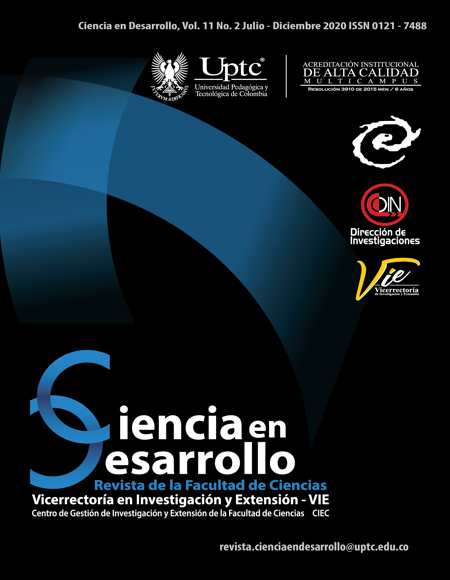Core/shell fibers of Carboxymethylcellulose/Poly(lactic acid) loaded with Curcumin.

Abstract
To dose curcumin (Cur) while avoiding its degradation, a polymeric material consisting of fibers with core/shell structure was designed. Coaxial electrospinning allowed us to obtain fibers with poly(lactic acid) (PLA) core, and carboxymethylcellulose (CMC) shell. CMC/PLA fibers were compared with conventional PLA fibers. Scanning electron microscopy images allowed us to characterize the core/shell structure of CMC/PLA-Cur fibers. The presence of Cur in the fibers was confirmed by Raman spectroscopy. Thermogravimetric analysis and differential scanning calorimetry showed the effect of Cur on the thermal behavior of the fibers, and showed contrasting behavior between CMC/PLA and PLA fibers. Cur release experiments were performed at physiological pH and the results were fitted with the Korsmeyer-Peppas model. The release rate of CMC/PLA fibers was significantly lower than that of PLA fibers.
Keywords
Carboxymethylcellulose, Poly (lactic acid), Curcumin, Core/Shell Fibers, Coaxial Electro-spinning.
References
- R. A. Perez and H. W. Kim, “Core-shell designed scaffolds for drug delivery and tissue engineering,” Acta Biomater., vol. 21, no. March, pp. 2–19, 2015, doi: 10.1016/j.actbio.2015.03.013. DOI: https://doi.org/10.1016/j.actbio.2015.03.013
- S. S. Rao et al., “Mimicking white matter tract topography using core-shell electrospun nanofibers to examine migration of malignant brain tumors,” Biomaterials, vol. 34, no. 21, pp. 5181–5190, 2013, doi: 10.1016/j.biomaterials.2013.03.069. DOI: https://doi.org/10.1016/j.biomaterials.2013.03.069
- Á. P. Sánchez Cepeda, R. Vera Graziano, E. de J. Muñoz Prieto, E. Y. Gomez Pachón, M. J. Bernard Bernard, and A. Maciel Cerda, “Preparación y caracterización de membranas poliméricas electrohiladas de policaprolactona y quitosano para la liberación controlada de clorhidrato de tiamina,” Ciencia En Desarrollo, vol. 7, no. 2, p. 133, 2016, doi: 10.19053/01217488.v7.n2.2016.4818. DOI: https://doi.org/10.19053/01217488.v7.n2.2016.4818
- “Methods for electrospinning core-shell fibers,” 2016. http://electrospintech.com/coreshellmethod.html#.V-_bKIjhDIU.
- A. Vaseashta, “Nanostructured Materials Based Next Generation,” Nanostructured Adv. Mater., pp. 1–30, 2005. DOI: https://doi.org/10.1007/1-4020-3562-4_1
- L. E. Sperling, K. P. Reis, P. Pranke, and J. H. Wendorff, “Advantages and challenges offered by biofunctional core-shell fiber systems for tissue engineering and drug delivery,” Drug Discov. Today, vol. 21, no. 8, pp. 1243–1256, 2016, doi: 10.1016/j.drudis.2016.04.024. DOI: https://doi.org/10.1016/j.drudis.2016.04.024
- L. Lizarazo-fonseca, E. de J. Muñoz Prieto, R. Vera Graziano, B. Camacho, G. Salguero, and I. Silva-cote, “Electrospun poly ( ɛ-caprolactone )/ collagen scaffolds with potential use for skin regeneration,” Ciencia En Desarrollo, vol. 10, no. 2, 2019. DOI: https://doi.org/10.19053/01217488.v10.n2.2019.9841
- X. Cai, Z. Fang, J. Dou, A. Yu, and G. Zhai, “Bioavailability of Quercetin: Problems and Promises,” Curr. Med. Chem., vol. 20, no. 20, pp. 2572–2582, 2013, doi: 10.2174/09298673113209990120. DOI: https://doi.org/10.2174/09298673113209990120
- G. R. B. Irving, A. Karmokar, D. P. Berry, K. Brown, and W. P. Steward, “Curcumin: The potential for efficacy in gastrointestinal diseases,” Best Pract. Res. Clin. Gastroenterol., vol. 25, no. 4–5, pp. 519–534, 2011, doi: 10.1016/j.bpg.2011.09.005. DOI: https://doi.org/10.1016/j.bpg.2011.09.005
- M. Herryman and G. Blanco, “Ácido láctico y poliláctico: Situación actual y tendencias,” Red Rev. Científicas América Lat. el Caribe, España y Port., vol. 39, pp. 49–59, 2005.
- Z. Rao et al., “Carboxymethyl cellulose modified graphene oxide as pH-sensitive drug delivery system,” Int. J. Biol. Macromol., vol. 107, no. PartA, pp. 1184–1192, 2018, doi: 10.1016/j.ijbiomac.2017.09.096. DOI: https://doi.org/10.1016/j.ijbiomac.2017.09.096
- J. Leon et al., “Caracterización Y Estudio De Liberación De Curcumina Cargada En Microfibras De Acido Polilactico,” Rev. la Fac. Ciencias Univesidad Nac. De Colombia, vol. 9, no. 1, pp. 125–141, 2020, doi: 10.15446/rev.fac.cienc.v9n1.81966. DOI: https://doi.org/10.15446/rev.fac.cienc.v9n1.81966
- S. Dash, P. N. Murthy, L. Nath, and P. Chowdhury, “Kinetic Modeling on Drug Release From Controlled Drug Delivery Systems,” Acta Pol Pharm, vol. 67, no. 217–223, 2010.
- S. Ramakrishna, K. Fujihara, W.-E. Teo, T.-C. Lim, and Z. Ma, “Electrospinning Process,” in An Introduction to Electrospinning and Nanofibers, 2005, pp. 1–11. DOI: https://doi.org/10.1142/5894
- M. A. Cuiffo, J. Snyder, A. M. Elliott, N. Romero, S. Kannan, and G. P. Halada, “Impact of the fused deposition (FDM) printing process on polylactic acid (PLA) chemistry and structure,” Appl. Sci., vol. 7, no. 6, pp. 631–632, 2017, doi: 10.3390/app7060579. DOI: https://doi.org/10.3390/app7060579
- E. López-Tobar, G. P. Blanch, M. L. Ruiz Del Castillo, and S. Sanchez-Cortes, “Encapsulation and isomerization of curcumin with cyclodextrins characterized by electronic and vibrational spectroscopy,” Vib. Spectrosc., vol. 62, pp. 292–298, 2012, doi: 10.1016/j.vibspec.2012.06.008. DOI: https://doi.org/10.1016/j.vibspec.2012.06.008
- F. X. Espinach, S. Boufi, M. Delgado-Aguilar, F. Julián, P. Mutjé, and J. A. Méndez, “Composites from poly(lactic acid) and bleached chemical fibres: Thermal properties,” Compos. Part B Eng., vol. 134, pp. 169–176, 2018, doi: 10.1016/j.compositesb.2017.09.055. DOI: https://doi.org/10.1016/j.compositesb.2017.09.055
- E. Duhoranimana et al., “Effect of sodium carboxymethyl cellulose on complex coacervates formation with gelatin: Coacervates characterization, stabilization and formation mechanism,” Food Hydrocoll., vol. 69, pp. 111–120, 2017, doi: 10.1016/j.foodhyd.2017.01.035. DOI: https://doi.org/10.1016/j.foodhyd.2017.01.035
- E. Siqueira, V. Botaro, and K. Novack, “Thermal and mechanical properties of films prepared with purified and unpurified carboxymethylcellulose (CMC),” in Investigation of the mechanical properties of magnesium metal matrix composites with a fine dispersion of CeO2 particles, 2014, no. 1, pp. 2665–2672, doi: 10.2466/pr0.1981.48.1.335. DOI: https://doi.org/10.2466/pr0.1981.48.1.335
- P. Pages, F. Carrasco, J. Gamez, and L. Maspoch, “Procesado del ácido poliláctico (PLA) y de nanocompuestos PLA/montmorillonita en planta piloto: Estudio de sus cambios estructurales y de su estabilidad térmica,” Afinidad LXVI, vol. 67, no. 545, pp. 107–113, 2010.
- Y. J. Wang et al., “Stability of curcumin in buffer solutions and characterization of its degradation products,” J. Pharm. Biomed. Anal., vol. 15, no. 12, pp. 1867–1876, 1997, doi: 10.1016/S0731-7085(96)02024-9. DOI: https://doi.org/10.1016/S0731-7085(96)02024-9
- J. Gonzalez and A. Et, “Curcumin and curcuminoids: chemistry, structural studies and biological properties,” An. Real Acad Farm, vol. 81, no. 4, pp. 278–310, 2015.
- J. Siepman and A. Göpferich, “Mathematical modeling of bioerodible, polymeric drug delivery systems,” Adv. Drug Deliv. Rev., vol. 48, pp. 229–247, 2001, doi: 10.1080/01430750.2017.1324812. DOI: https://doi.org/10.1016/S0169-409X(01)00116-8
- J. Fernández, R. González, and G. Estevez, “Cinética de liberación de cefalexiana desde un biomaterial compuesto por HAP-200/POVIAC/CaCO3,” An. R. Acad. Nac. Farm, vol. 75, no. 3, pp. 345–363, 2009.
